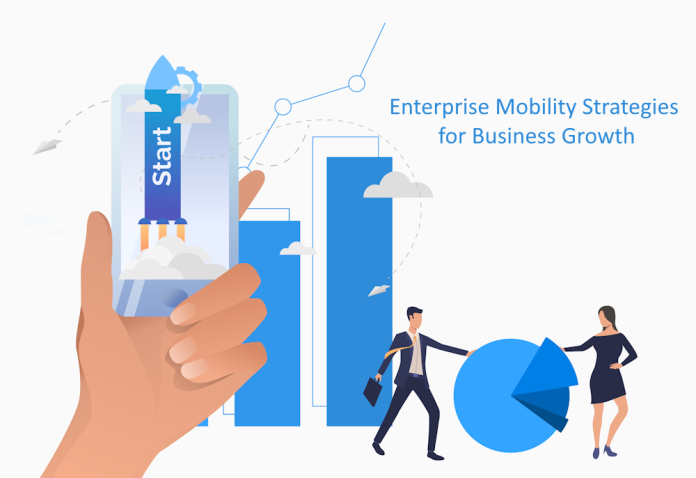Enterprise mobility is the practice of conducting business beyond a traditional office environment, often enabled by the use of smartphones, tablets, and laptops. In our technology-driven world, it has become integral to the operations of most modern businesses. Enterprise mobility allows organizations to leverage mobile technology to improve productivity, deliver better customer service, and reduce operational costs. As businesses become increasingly global, the importance of being able to work from anywhere, at any time, is clear. In this document, we will explore the key components of an effective enterprise mobility strategy, successful case studies, challenges in implementation and the future of enterprise mobility.
Table of Contents
Understanding the Role of Enterprise Mobility in Business Growth
Enhancing Productivity
Enterprise mobility allows employees to work anywhere, anytime, thereby fostering a culture of productivity. It eliminates the limitations imposed by traditional office settings and enables employees to accomplish tasks from virtually any location. This not only leads to increased productivity but also empowers employees with a better work-life balance, resulting in higher job satisfaction and retention rates.
Improving Customer Service
With the ability to access information and resources on the go, employees can provide faster and more efficient customer service. This capability can significantly improve customer satisfaction and boost brand reputation. For instance, field service workers can access real-time information and provide prompt solutions to customer issues, leading to a positive customer experience.
Reducing Operational Costs
By reducing the need for physical office space and related expenses, enterprise mobility can help businesses save significantly on operational costs. With the use of mobile devices and cloud services, employees can collaborate and communicate seamlessly without the need for expensive equipment or infrastructure. Additionally, with employees using their own devices, it eliminates the cost of providing company-owned devices.
Ensuring Data Security
With the increasing use of mobile devices and cloud services in business operations, data security becomes a primary concern. Enterprise mobility solutions offer advanced security features, such as data encryption, multi-factor authentication, and remote wipe capabilities, to protect sensitive business information. This ensures that company data remains secure even in the event of a lost or stolen device.
Enabling Innovation
Enterprise mobility provides businesses with the flexibility to adopt new technologies and approaches quickly. With employees able to work from anywhere, businesses can explore innovative tools and strategies, leading to increased productivity, efficiency, and competitiveness. Additionally, mobile apps can be developed for specific business needs, providing tailored solutions that cater to the unique requirements of a business.
Boosting Employee Satisfaction
With the ability to work remotely and access necessary resources on their mobile devices, employees experience increased flexibility in their work schedules. This can lead to improved work-life balance and job satisfaction, resulting in higher employee retention rates. Furthermore, enterprise mobility solutions enable employees to stay connected and collaborate effectively, fostering a sense of community and teamwork within the company.
Key Components of an Effective Enterprise Mobility Strategy
Effective enterprise mobility strategies are built on three key pillars: user experience, integration of emerging technologies, and a mobile-first approach.
User Experience
A good enterprise mobility strategy prioritizes user experience. The aim is to provide a seamless, easy-to-navigate interface that helps employees perform tasks efficiently. This includes providing a consistent user experience across different devices and platforms, as well as ensuring security measures do not hinder productivity.
Integration of Emerging Technologies
As technology continues to evolve, businesses must keep up with the latest trends and incorporate them into their enterprise mobility strategy. These emerging technologies can provide new opportunities for employees to work smarter and more efficiently. Examples include artificial intelligence, augmented reality, and Internet of Things (IoT) devices.
Mobile-First Approach
With the majority of employees now using mobile devices as their primary means of accessing information and completing tasks, businesses must adopt a mobile-first approach in their enterprise mobility strategy. This involves prioritizing the design and functionality of mobile applications to ensure they meet the needs and expectations of its users.
Overcoming Challenges in Enterprise Mobility Implementation
While implementing an enterprise mobility strategy presents its own set of challenges, they can be effectively managed with a comprehensive understanding and well-planned approach. In this ‘Enterprise Mobility Guide’, we will discuss some common obstacles businesses may encounter in their journey towards enterprise mobility, as well as potential solutions to these challenges. Factors such as ensuring robust security, managing diverse devices, and maintaining high-quality performance across all platforms can pose significant hurdles. However, through strategic planning, the use of advanced tools, and the incorporation of industry best practices, businesses can overcome these challenges and successfully set up a thriving enterprise mobility system.
The Future of Enterprise Mobility
The future of enterprise mobility is set to be shaped by advancements such as 5G, IoT, AI, and machine learning. These technological shifts will continue to redefine how businesses operate, offering new opportunities for growth and innovation. With the rise of remote work and the ever-increasing reliance on mobile devices, it is crucial for businesses to stay ahead of these trends and continually adapt their enterprise mobility strategies to deliver a seamless user experience. By adopting a mobile-first approach and continually monitoring advancements, businesses can ensure they remain competitive in today’s rapidly evolving digital landscape.
Conclusion
In conclusion, the importance of enterprise mobility for business growth cannot be overstated. Businesses should not only embrace enterprise mobility but also be prepared to adapt to its evolving nature. With a well-planned strategy and a forward-thinking approach, businesses can harness the power of enterprise mobility to drive growth and remain competitive in the digital age. By understanding the challenges and opportunities presented by enterprise mobility, businesses can make strategic decisions that will benefit their employees, customers, and overall success. So embrace enterprise mobility as a key aspect of your business strategy and stay ahead of the game in this ever-changing digital landscape. So keep moving forward with enterprise mobility, and see where it takes your business in the future!












